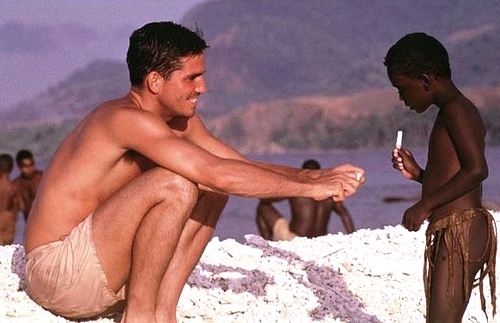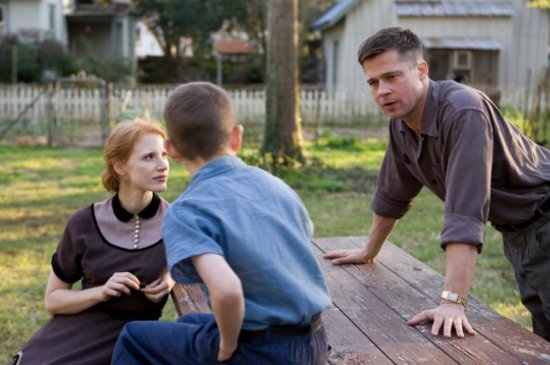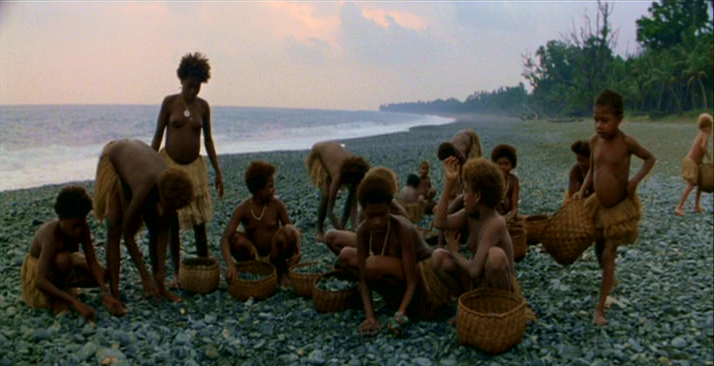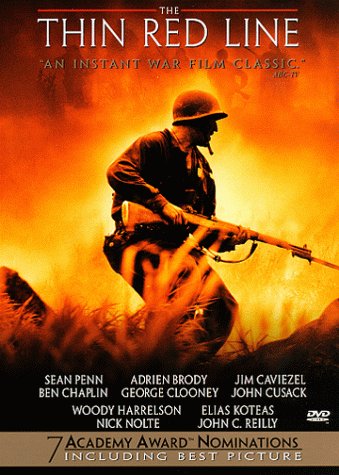
I can’t remember how I regarded the World War II set The Thin Red Line when I first saw it in 1998 but I can at least jar my memory enough to remember that I had embalmed some kind of admiration. It’s likely in conjecture that I was overpowered and startled by some of its awesome horror, and mystified and flustered by some of the rest. On the simplest level the film is war vs. nature. That can be deciphered upon a first viewing – the natural beauty of the Guadalcanal gets ripped apart. But I have now seen this Terrence Malick film four times including the last viewing over the weekend. Not only is it at its furthest an unnerving battle spectacle and a poetic exploration into the deepest subconscious thoughts of soldiers, but it is also contains codas that accompany Malick’s latest film “The Tree of Life.”
Early on, Jim Caviezel (as Private Witt) has been found AWOL by a Navy patrol vessel and reinstated back into service by Sean Penn (as Company First Sergeant Welsh) who serves him with a stern lecture.
“In this world… a man, himself is nothing. And there ain’t no world but this one,” Penn says, echoing Brad Pitt’s patriarchal outlook in “The Tree of Life.”
“You’re wrong there, Top. I seen another world… Sometimes I think it was just my imagination.” (This could be the ethereal rapture that Penn seeks in “The Tree of Life.”)
“Well, you’ve seen things that I never will,” Penn says. “We’re living in a world that’s blowing itself to @#!*% as fast as everybody can arrange it. In that situation, all a man can do is shut his eyes and let nothing touch him. Look out for himself.”
That last statement is the degraded encasement that man chooses to live in, as reflected on in “The Tree of Life,” that since mankind cannot agree upon a shared world, we subjugate ourselves. Pitt teaches his son to not cross the property lines in Malick’s latest and that he is restricted to play only on his lawn. In “The Thin Red Line,” Sergeant Welsh concedes that the attack on the South Pacific islands in World War II comes down to property lines.


On the island, the battalion operation is to seize the Japanese airfield which is a site that controls their route to Australia and sovereign the sea lanes to America. The attack necessitates the battalion climb a steep hill where at the top of the knoll rests Japanese machine gun bunkers and mortar mounds. Nick Nolte (as Lieutenant Colonel Tall) commands his units to attack head-on while he watches from a remote post. Elias Koteas (as Captain Staros), at the front lines, requests for his platoon to flank the enemy through the contiguous jungle, time costly it will be, but it will also diminish casualties. Koteas pleads, “I don’t think you understand what is going on down here, Sir.”
Just as hard a protest consists of platoon captains begging Nolte to halt the raid so the men can be satiated with water. Men can die from no water just as they can from a bullet, is the concern. “The only time you should start worrying about a soldier is when they stop @#!*% ’,” Nolte barks. Underneath the Japanese shell firing, Koteas and Nolte debate about how many men are worth sacrificing in order to achieve victory. Nolte is facetious when he posits with Koteas on whether he is willing to lose at least twenty men. Hundreds lost would seem to be OK with Nolte who wants victory and a hopeful rank promotion to General.
The battle is agonizingly exciting, in the way the camera sweeps along the soldiers through blades of grass that rest nowhere – it’s hard to stand and see the enemy above without becoming a target. Soldiers are sitting ducks until they find a shielding ledge to drop under, until then, they sprint for a little then drop face-down. The most heart-stopping sequence is with John Cusack (as Captain Gaff) leading a small company of men uphill to take the heavily guarded bunker that consists of smoking out the bunkers and holding off charging Japanese soldiers.
The outfit succeeds in seizing control, but the control is just of one part of the island. The fighting at least for awhile desists and falls into rest and recreation. Malick goes further into letting us know the pains and fears of the men.
What was mystifying and flustering upon the first time of seeing the film is that I couldn’t tell whose voice-over belonged to whom. Caviezel, Koteas, Penn, Ben Chaplin, Woody Harrelson and too many others to list all sound alike, this especially when the camera is pointed not at persons but at the tropical birds, the bamboo trees, the reef, and the soils of the earth. Now it’s translucent that the voice-over is not shackled to one individual but stands to represent all men who possess a ubiquitous affinity. “Maybe all men got one big soul who everybody’s a part of with all faces of the same man… one big self,” a wisdom that is specifically attributed to Caviezel’s Private Witt.
One thing that does separate Caviezel from the others is that he loves his enemy. Sure, he aims and fires at them but he acknowledges their bravery. Strongest man lives, sort of thing. He is kind to the ones that surrender. Caviezel also loves his fellow outfit and looks after the most the ones who tremble in fear of dying. This is most lucidly demonstrated during the film’s “climax,” where Caviezel is on reconnaissance with two other soldiers, one of them injured. Caviezel’s sense of peace that he abides by is ennobling.
Other than Caviezel, the Melanesian natives are at most in peace. They inhabit the island, it’s theirs really, but they do not stray from their own villages. The fighting between Americans and Japanese happens around them. Caviezel wants to be a part of them again just like at the beginning of the film during his AWOL escapades. The natives don’t regard him in the same way now that he is in his armed forces attire.
Without a doubt, the most lingering shot of the film is of an ash-covered bird that has had its wing blown off, fluttering helplessly in circles. Nature and its’ creatures are as big a victim of war as anything else. But the destruction of war is specifically ruining it for the peaceful Melanesian people whom are not a part of anything except their own harmony. It is their land that is being ruined by outsiders that don’t respect their habitat. The American GIs’ dream of a sweeter Eden but haven’t quite found it because their command orders are to blow it up.

The film also features Adrien Brody, George Clooney, Thomas Jane, Jared Leto, Tim Blake Nelson, John C. Reilly, John Savage, Nick Stahl, John Travolta. Seven Oscar nominations included Best Picture running alongside “Saving Private Ryan” in 1998, both losing to “Shakespeare in Love.”






